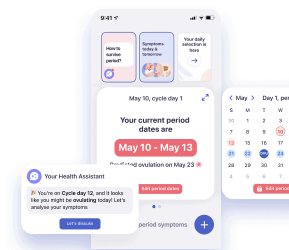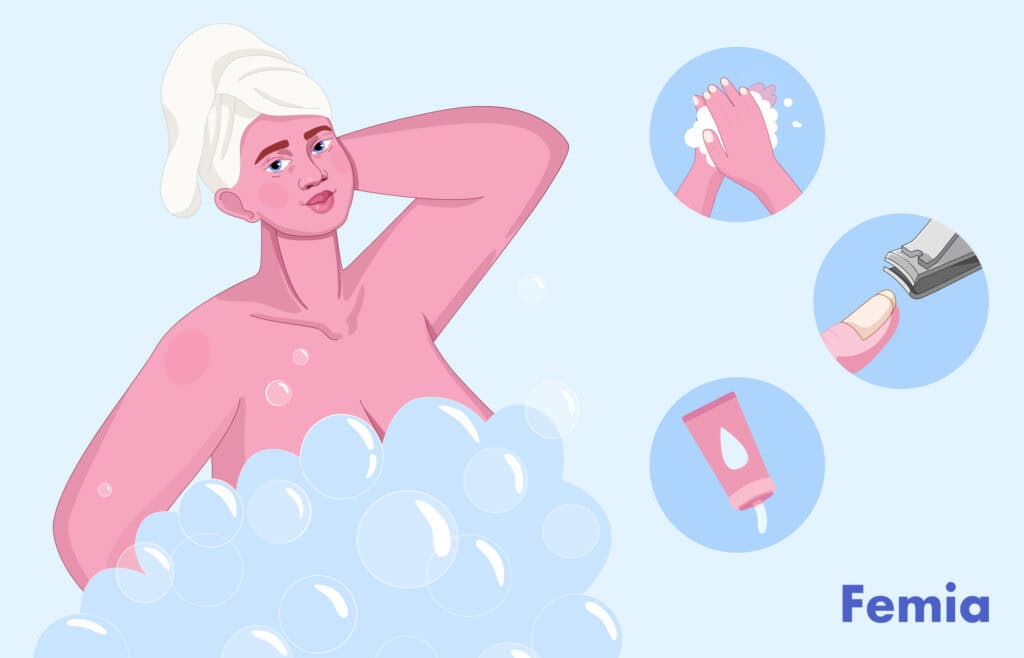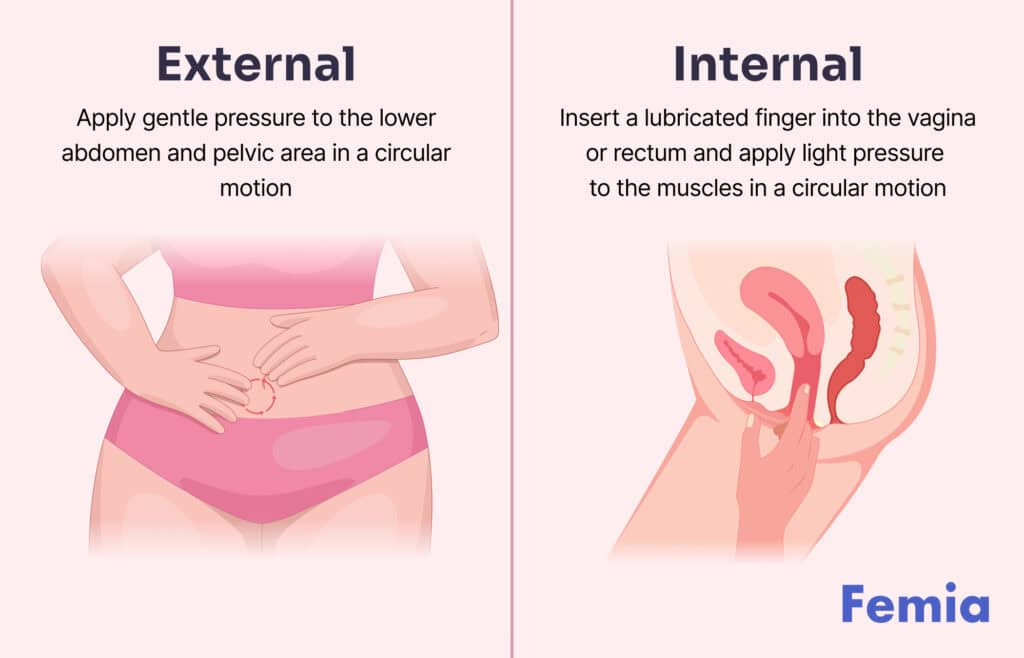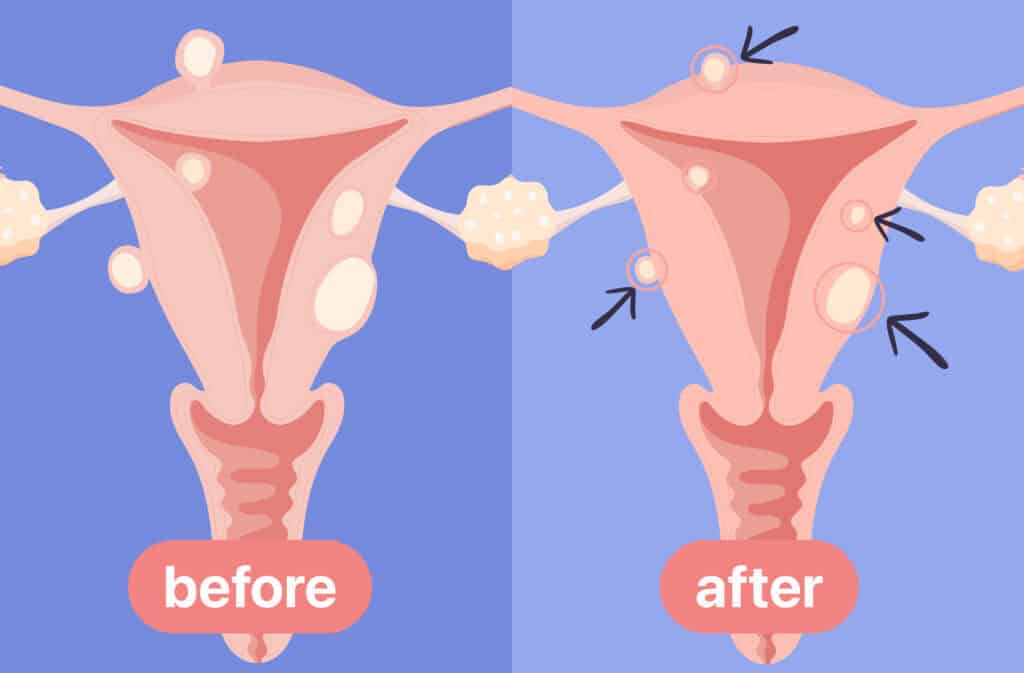Femia > Health Library > Your cycle > Health > Pelvic floor massage 101: How to relieve pain and improve function
Pelvic floor massage 101: How to relieve pain and improve function

- Updated Mar 2, 2025
- Published
CRAFTED BY HUMAN
Crafted by human At Femia, we provide accurate and up-to-date information at every stage of your journey, from trying to conceive, pregnancy and postnatal support. All content is created by a real person based on in-depth research and own professional experience. Femia ensures that you will receive expert advice, strict accuracy and a personalized approach from our authors/medical experts. Learn more about our editorial policy.
FACT CHECKED
Fact checked At Femia Health, we maintain the highest standards of editorial excellence in delivering content focused on helping you conceive, guiding you through pregnancy, and supporting you postpartum. Explore our content review principles to learn how we ensure the accuracy and quality of our health and lifestyle tips for every stage of your journey.
Pelvic floor health is vital for women’s organ support, reproductive health, and pain management. Weak pelvic muscles can cause incontinence and organ prolapse. Pelvic floor massage, combined with exercises and good posture, can strengthen these muscles and improve overall well-being.
Pelvic floor health is an important aspect of every woman’s life. These muscles play a key role in supporting the pelvic organs, such as the bladder, uterus, and rectum. Weakened pelvic floor muscles may cause you to lose control of urination and bowel movements. Childbirth can also weaken the pelvic floor muscles, which adds to the discomfort of recovery.
However, despite its important role in the body, many women remain unaware of their pelvic health or how to support it, especially after giving birth. So, in this article, we’ll tell you all about why pelvic floor health is important and how to improve it with pelvic floor massage.

Why is pelvic floor health so important?
The pelvic muscles play an important role in supporting several bodily systems, especially after childbirth. Unfortunately, the impact that weak pelvic muscles can have on a woman’s quality of life is often not discussed enough. For example, a study by Kailey Snyder of postpartum women residing in communities with less than 50,000 residents showed that most women had concerns about their pelvic health and a negative attitude about available resources.
Here are some of the main things that pelvic floor health can affect:
1. Organ support
The pelvic floor supports the pelvic organs, including the bladder, uterus, and rectum. Weak muscles can lead to prolapse—a downward displacement of organs, such as the uterus descending into the vagina, or extending beyond it.
Your rectum could also move into your vagina, resulting in significant pain and uncomfortable, constant pressure in the pelvis, anus, and back. In this case, painful sensations may intensify with physical activity.
2. Reproductive health
The pelvis plays an irreplaceable role during conception, pregnancy, and childbirth, so keeping these muscles in good shape is important. A weak pelvic floor can make pregnancy even more challenging, whereas a firm and elastic pelvic floor will allow faster recovery after the birth.
3. Pelvis and back
A weakened pelvic floor can lead to poor posture and increased stress on other muscles, causing chronic pain in the pelvis and lower back. A healthy pelvis and back rely on a strong pelvic floor and many healthy, supportive muscles.
Awareness is everything. When you’re more aware of what exactly is happening in your body and why it’s important, you can respond better. In this case, pelvic floor health is especially crucial after birth. So, now that you know some of the complications that weak pelvic floor muscles can cause, let’s learn what to do about it.
👉Find out more: Endometriosis self-care: tips for managing symptoms and boosting fertility

What is pelvic floor massage?
Pelvic floor massage is a therapeutic technique that aims to improve the condition of the muscles and tissues of the pelvic floor. It can help women recover from a variety of health problems and is most often recommended as a postpartum exercise.
Pregnancy and childbirth often weaken or damage women’s pelvic muscles, and massage helps speed up the tissue healing process and improve blood circulation. It can also help generally strengthen the muscles and improve conditions associated with weakened or dysfunctional pelvic floor muscles, like incontinence.
Pelvic floor massage can sometimes help women with back or lower back pain, too. Chronic pain can be caused by spasms or constant muscle tension, and massage can relieve that pain by relaxing the muscles.
Finally, pelvic floor massage isn’t only useful for treating specific health issues. Strengthening the pelvic muscles can build endurance and improve blood circulation to the genital area, meaning greater sensitivity, better sex, and less risk of injury.
@femia.fertility Boost your chances of conceiving with these three fertility exercises. Incorporate these simple moves into your daily routine to strengthen your pelvic floor muscles and enhance your reproductive health #fertility #fertilitytips #pelvicfloor #pelvicfloorexercise #fertilityexercises #exerciseforfertility #ttctips #fertilitysport #fertilityjourney #exercises #fertilityworkout ♬ original sound - Femia fertility app
How to prepare for a pelvic floor massage?
A pelvic floor massage is something you perform on yourself, so take some time to get comfortable and prepare. Create conditions for relaxation by choosing a quiet space with soft lights and a comfortable temperature. If you wish, you can light candles to create the atmosphere.
To avoid infections or discomfort, take a shower or wash your pelvic area before the procedure. Be sure to also wash your hands thoroughly, paying special attention to your fingertips and nails. If you have long nails, it is recommended to cut them, as there is a risk of damaging the delicate tissue of the vagina.
Don’t forget to purchase a lubricant that will reduce friction and relieve discomfort.
Take a position that is comfortable for a massage! The most commonly used body positions are:
1. Lying on your back
Lie on your back with your knees bent and legs apart. Use pillows to make your position comfortable, especially making sure to place one under your back.
2. Lying on your side
If you want to do the massage while lying on your side, bend your top leg at the knee and pull it towards your chest.
If you are very tense, you can massage your stomach a little in a circular motion. It promotes relaxation and allows you to better tune in to the massage.

How to massage pelvic floor muscles?
There are two types of massage techniques, external and internal. We’ll discuss how to perform both, so start where you’re comfortable. Being relaxed is key!
1. External techniques
Targeting painful areas or any muscles that feel sore and/or tense, apply gentle pressure to the lower abdomen and pelvic area in a circular motion. Keep the pressure light at first, just using the fingertips, then gradually work your way to the full hand while applying a little more force. Adjust the pressure as needed—it shouldn’t be painful.
2. Internal pelvic massage techniques
For this method, you will gently insert your finger into your vagina or rectum. So, apply lubricant to your fingers first to make this more comfortable (a water-based one is best).
Moving in a circle, apply light pressure to the sides, back, and front of the pelvic floor muscles. If you notice a painful area, or if the muscles seem too tight, try holding pressure on that area for a few seconds, and repeat as necessary.
If you are having bowel movement problems, inserting your finger into the rectum will be more effective. However, the method may also seem uncomfortable or even painful, and it requires preparation.
👉Find out more: Toxic metals found in tampons: What you need to know

Internal or external massage?
Both massage techniques improve the condition and functionality of the pelvic floor. They both apply to different diagnoses, such as urinary incontinence or prolapse.
However, internal massage is more effective. It allows you to work more accurately with muscles and more effectively influence the site of pain. The best solution, however, is to combine both techniques. External massage is often used as a preliminary treatment.
What else, besides massage, can help restore the pelvic floor?
There are also other ways to restore the pelvic floor. For the fastest recovery, it’s best to combine several methods.
- For example, you can do yoga and meditation. Very moderate exercise aimed at strengthening the body and increasing endurance can help tone muscles.
- Try to maintain correct posture. The correct back position ensures minimal pressure on the vertebrae and pelvis. Try supporting your back with a pillow while sitting.
- Refrain from lifting heavy things if you have fairly weak lower pelvic muscles. Also, do not strain your pelvic muscles too much when defecating and urinating. It may help prevent pelvic floor injury and dysfunction.
👉Find out more: 7 steps to getting pregnant with blocked fallopian tubes
Kegel exercises
Kegel exercises for the pelvic floor were named after gynecologist Arnold Henry Kegel. Such exercises can help prevent urinary incontinence or restore better bladder control.
If you want to try the exercise, contract the muscles around your vagina as if you were trying to stop urinating. You should not tense your gluteal or abdominal muscles while performing Kegel exercises.
Squeeze these muscles for 3-5 seconds, gradually increasing the time of contraction as the muscles become stronger. Remember to relax your muscles and give them a short break. The time between contractions should not be shorter than the contractions themselves.
It is better to perform the exercise more than 10 times, even several times a day. It may sound boring, but the exercise can be done almost anywhere! And, if it helps you do it more often, you can do it to the rhythm of any song.
When performing Kegel exercises, it is crucial to breathe evenly and calmly. Avoid holding your breath, as it can lead to unnecessary tension and discomfort.
Instead, focus on rhythmic breathing: in through your nose, out through your mouth. It will help you relax and concentrate on doing the exercises correctly, which increases their effectiveness. Smooth breathing also promotes better blood circulation in the pelvic floor, improving workout results.
How is organ prolapse treated?
Organ prolapse may sound terrible, and although the diagnosis is indeed disappointing, there are solutions for such cases.
- Conservative methods. Dramatic changes in lifestyle to healthier alternatives and constant exercise with vaginal balls. Physical therapy with proper exercises also helps to keep organs in the correct position. These methods can be effective, particularly for mild prolapse and sometimes for moderate prolapse, provided they are practiced regularly and not just occasionally.
- Drug treatment. Patients (only applicable to postmenopausal women) may be prescribed estrogen in the form of creams or tablets.
- Surgical intervention. Most often occurs when the pelvic floor is severely damaged. Specialists can restore supporting tissues using sutures and implants and, in rare cases, prostheses.
👉Find out more: Signs of ovulation after stopping taking birth control pills

Questions from the Femia community
Is pelvic floor massage safe for everyone?
Generally, yes, but don’t forget about the main danger – nails. A long and beautiful manicure will be a real nightmare if you want to massage the lower pelvis, so don't forget to trim your nails. Keep your nails short and clean to avoid self-injuries and reduce the chances of carrying bacteria into the vaginal area.
Consult with a healthcare provider if you have specific medical conditions or concerns.
How often should I perform a pelvic floor massage?
The answer varies; some people benefit from weekly sessions, while others may need it less frequently. If you feel like you need to do it more often, then go ahead! Regular massages are always the most effective for the health of the lower pelvis.
Plus, it helps keep your muscles toned! However, if you doubt the effectiveness of frequent massages, it is better to consult with a healthcare provider.
What if I feel pain during pelvic floor massage?
Regular massages can help relieve pain, but mild discomfort is normal. must regulate the pressure yourself, based on your sensations. Still, sharp pain should not occur. Stop if you feel severe pain and consult a healthcare provider.
Can pelvic floor massage help with painful sex?
Yes, pelvic floor massage can help relax tight muscles and reduce discomfort, making sex more enjoyable. However, when massaging internally, be sure to apply enough water-based lubricant to reduce friction and help the muscles relax.
Is pelvic floor massage beneficial during pregnancy?
Absolutely! It can help alleviate pelvic pain and prepare the muscles for childbirth. However, always consult your healthcare provider first.
Can I use tools or devices for pelvic floor massage?
Yes, there are specialized tools like pelvic wands or dilators that can help with internal massage. Ensure they are clean, and use them according to instructions.
The bottom line
Pelvic floor massage is an important element for the full restoration of your body. It is vital to keep your muscles toned to support the many systems and functions of our bodies. Remember to take care of yourself, and always consult your healthcare provider if you feel something is wrong.
References
- “Pelvic Floor Complications During Childbirth- a Systematic Review and Meta-Analysis.” Raed Eid Alzahrani. 2024. Available at: https://jpmsonline.com/article/jpms-volume-13-issue-2-pages86-92-ra/#section-471-1991
- “Perceptions of pelvic health among postpartum women in rural communities.” Kailey Snyder, Elizabeth Mollard, Kari Bargstadt-Wilson, Julie Peterson. 2022. Available at: https://www.ncbi.nlm.nih.gov/pmc/articles/PMC9510969/
- “Perineal Massage Improves the Dyspareunia Caused by Tenderness of the Pelvic Floor Muscles.” Ana Paula Moreira da Silva, Mary Lourdes Montenegro, Maria Beatriz Ferreira Gurian, Andréia Mitidieri. 2016. Available at: https://www.researchgate.net/publication/311940623_Perineal_Massage_Improves_the_Dyspareunia_Caused_by_Tenderness_of_the_Pelvic_Floor_Muscles

Discover how to shrink fibroids naturally at home with diet, lifestyle changes or medical treatments and when to see a doctor.

Wondering if you can eat honey while pregnant? Learn its benefits, risks, and safe practices for consumption during pregnancy to help with symptoms like nausea and constipation.

Discover why bloating during ovulation occurs, if it is normal, and its symptoms, causes, how long it lasts, how to relieve it, and more.

